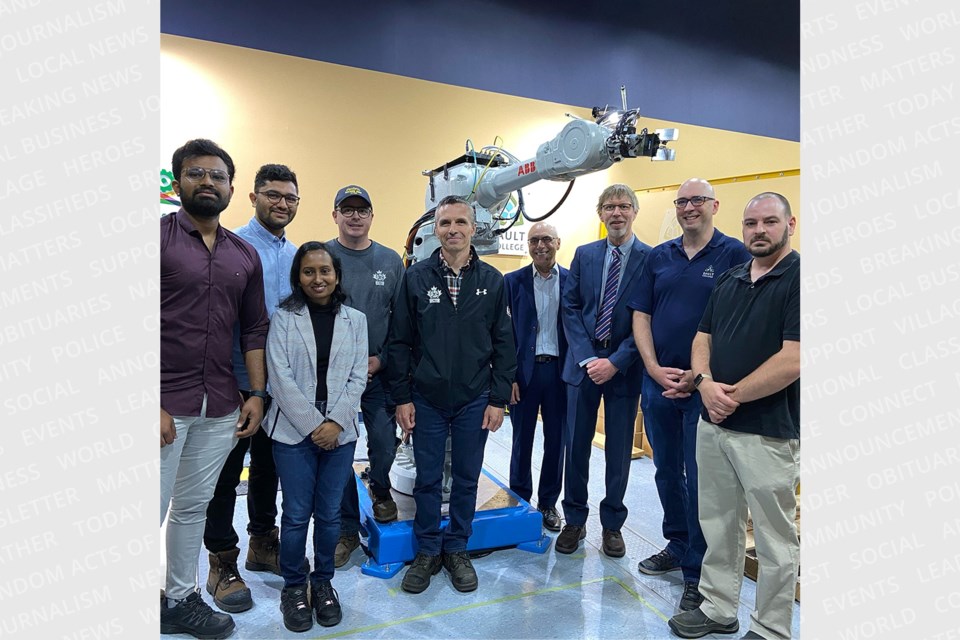Sault College representatives, in collaboration with Rector Machine Works, have completed a three-month-long project to help create a safer work environment, a news release issued today states.
The project includes a robotic solution for assisting in operations.
“Our main goal was to improve health and safety and create a safer work environment. It simply minimizes the exposure to risks associated with repetitive stress, injuries and muscle fatigue. A robotic solution also offers repeatability and improves efficiency for labour intensive processes,” said Brian Belec, Rector Machine Works.
Full text of the release follows:
Today, representatives from Sault College showcased their most recent applied research project developed in collaboration with Rector Machine Works. Project Manager, Paul Larsen, Robotics students, Amy Martin, Ayush Patel and Suvir Anaghan, and advising Professors Donovan Kennedy and Chris Beauchamp demonstrated the proof-of-concept project that included a robotic solution for detangling parts to assist in Rector’s operations.
The project, which took approximately three months, was funded through a grant from the Natural Sciences and Engineering Research Council of Canada. The goal of the grant program is to transfer knowledge from the College to Canadian industry while helping to solve a company specific manufacturing issue.
Throughout this project, students were exposed to experiential learning and the opportunity to research and develop a concept that Rector Machine Works can adapt and implement to help streamline their operations.
“It has been amazing to see this project through to fruition and realize the many benefits of this work. This project not only helps local industry, but also gives our students valuable career-building work experience,” said Paul Larsen, Project Manager. “Additionally, the College is able to keep the vision system purchased for the project, which is another great addition to our lab for future learning and use,” he added.
For Rector Machine Works, this research project offers various benefits. “Our main goal was to improve health and safety and create a safer work environment. It simply minimizes the exposure to risks associated with repetitive stress, injuries and muscle fatigue. A robotic solution also offers repeatability and improves efficiency for labour intensive processes,” added Brian Belec, Rector Machine Works.
Sault College’s Applied Research Centre continues to look for opportunities that not only support student learning and an opportunity for students and staff to participate and solve real-world challenges, but also help our local enterprises adapt new technologies and develop new and improved products and processes that enable them to be competitive in today’s global marketplace. For more information about applied research at Sault College, visit Applied Research Centre | Sault College.
Backgrounder on the Rector Machine Works project:
Rector Machine Works is a modernized machine and fabrication shop, and the manufacturer of anchor plates, precision steel consumables used by Algoma Steel in their advanced Direct Strip Production Complex (DSPC). With Algoma Steel going through a growth phase, Rector would like to stay competitive in this industry by continuing to develop and expand its manufacturing capacity with an automated solution. While Rector uses precision automation machining stations, untangling rough-cut steel anchor blanks is a production bottleneck. Currently the heavy, rough anchor blanks are untangled by hand, a slow process. The collaborative project with Sault College will involve using a vision camera and custom software to capture the position of the tangled anchor blanks on a pallet adjacent to the robot. The vision camera will then transfer the lateral and rotational offsets of the steel parts to the robot. The robot will then apply these offsets which will result in the careful freeing of each interlocked part, requiring no manual intervention. This will result in faster throughput of the entire process. Sault College’s robot lab is ideal for this project, since the college has an industrial robot large enough to lift the heavy anchor, as well as utilize our vision cameras and software to conduct a proof-of-concept project.
